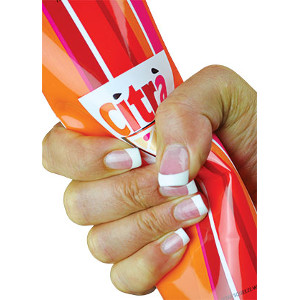Choosing the perfect label and adhesive for your packaging needs isn’t exactly easy. It requires a balance of durability and high-impact shelf appeal. When it comes to making informed choices about adhesives, there are always a lot of factors to consider about your application. What will the end-use environment be like? What sort of performance attributes does your packaging need? What are the aesthetic requirements? It may seem as though these concerns are far removed from the often invisible adhesive layer, but in reality they can make a big difference. And in this piece we’ll take a look at why this is the case, as well as what you should keep in mind to make sure your packaging will look, feel and last exactly the way you want it to.
For the flexible packaging industry, there are two main types of adhesives of which you should be aware: acrylic and rubber-based. While they each serve the same essential function – making one substrate stick to another – they do so in different ways, affecting everything from processing to performance. Possessing a basic knowledge of each category is a great first step toward making the right choices when using these adhesives in film-related applications.
Acrylic Adhesives
Acrylics are the most dominant type of adhesive in the flexible packaging market today. While they can be engineered to emphasize various performance properties, in general, acrylic adhesives often possess good durability, color stability, clarity, temperature resistance and chemical resistance. These adhesives are typically solvent or emulsion coated onto substrates.
For flexible packaging applications, they can be tailored to deliver great visual appeal that will stand up in challenging environments. MACtac’s MP880 acrylic adhesive, for instance, is optically clear and possesses excellent water and water whitening resistance, making it ideal for use when you are applying films to clear packaging and do not want an adhesive to draw any attention. This sort of product also offers extended open time so that films or labels can be repositioned easily when they’re being applied to packaging.
Rubber-Based Adhesives
Rubber-based adhesives are sometimes called “hot melts” because of how they are coated – they are melted down from solid form via application of intense heat and are applied to a substrate accordingly. While not as common in the flexible packaging market as acrylics, rubber-based adhesives are growing in popularity due to improvements in technology and the fact that there are no unwanted residual chemicals after hot melt coating, as can be the case with solvent and emulsion coating processes.
Rubber-based adhesives, as a rule, are more aggressive than acrylics, making them good options when permanent adhesion is desired. As is the case with acrylic adhesives, rubber-based adhesives are available that are optically clear and resist water and water whitening – such as MACtac’s PUREtac CL216 adhesive – and are compelling options for applying films to packaging where permanence is more desirable than repositionability.
Keep in mind that there is not a “best” option between rubber-based and acrylic adhesives necessarily; what makes the most sense for your application will always depend on packaging materials and how the product will be used.
End-Use Considerations
When deciding whether to use an acrylic or rubber-based adhesive, and in determining which specific adhesive to use within that category, it is advisable to start by considering necessary resistances. Think about the end-use environment: What sort of temperature will the packaging be exposed to? Will it be hot, cold or freezing? Will there be sustained humidity or water exposure? Will there be much ultraviolet light? Not all adhesives are designed to be used in extreme temperatures, and some adhesives that look clear could whiten or yellow when exposed to moisture or sunlight, so be sure you consult product literature and talk to adhesive suppliers if you are unsure which adhesive will be best for these situations.
Ambient conditions are not all that matter in end-use packaging environments, though. Some adhesives need very specific physical resilience as well, to ensure that they last based on packaging handling and usage requirements. Consider, for instance, whether your packaging might be exposed to a microwave, dishwasher or chemicals during the course of its lifespan. What sort of mandrel hold rating will be required of the adhesive? Does an adhesive need to be certified as safe for food contact? Again, in many cases product literature can help you find an adhesive that meets these needs, but it may be simplest to just work directly with a knowledgeable supplier.
Packaging Material Considerations
Beyond end-use environments, consider also the materials to which an adhesive must stick. Different adhesives stick better to some surface types than others. Not everything sticks well to low-surface energy containers, for instance – you may want a rubber-based adhesive for this, or a highly engineered acrylic. Textured containers may need a soft, cold-flow, high-tack adhesive with a higher-than-average coat weight that flows well into crevices, alternatively.
The shape of the container is also important. Ask yourself, “Will the container be curved or flat? Will it be squeezed?” Squeezing matters not only for the adhesive, but for the film it is adhering, so seek out a product like MACtac’s Vivid Squeeze if you know your end use will require a film to conform well when being continually compressed.
Aesthetic Considerations
Finally, consider how you want your packaging to look and how the adhesive may affect this. Especially with a rise in the popularity of clear labeling, a need for clear adhesives that won’t whiten when exposed to water (and will not be otherwise aesthetically compromised) is important. When choosing a clear adhesive, do not forget to factor in performance qualities, since choosing between ultimate adhesion or repositionability as a priority may be the best way to pick. Also, if you are considering implementing peel and re-seal functionality into a container, be sure that you choose an adhesive optimized for this type of usage to ensure products stay fresh.
As is the case with many things in life, engineering a sticky film that will last in flexible packaging applications is all about balance. If you are unsure of the right mix between performance and appearance, talk to a trusted supplier – they know adhesives best and can guide you to the best choice. With a little bit of knowledge and the right advice, you should be well equipped to find the perfect adhesive for your flexible packaging application.

For flexible packaging, labels with squeezable films featuring a high-tack adhesive, such as MACtac’s Vivid Squeeze, are engineered to conform well when being continually compressed.
MACtac
(866) 262-2822
www.mactac.com



